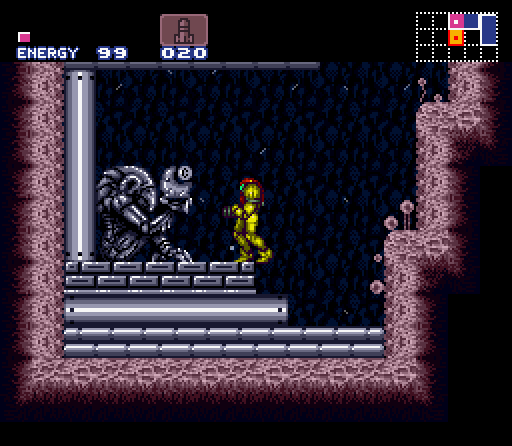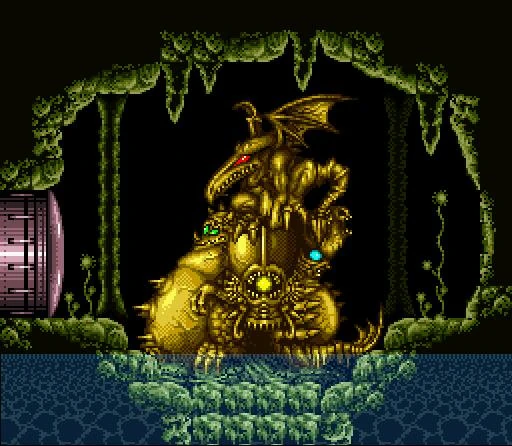Super Metroid is one of my favorite games ever - a large action-adventure side-scrolling platformer with plenty of powerups and much exploration of its intricate, ingenious level layouts. Super was a mindlessly common pattern for titles for the Super Nintendo, but this title truly deserves it.
 |
| The last Metroid is in captivity. The corpses are in peace. |
The game opens with a memorable prologue telling us the finale for Metroid 2, where Samus finds the last Metroid hatch and as it opens the baby Metroid follows her around. Unable to shoot away the creature, she delivers it to a team of scientists at the CERES space station. The findings of the scientists about the energy absorbing properties of the creature were amazing and they found they could use such properties for the good of mankind. Unfortunately, Samus was barely off to other venues when she catches a distress signal: CERES Station was attacked! She heads back and we're in game. After the prologue, a Space Pirate gets the Metroid and Samus follows close, eventually getting to a seemingly dead planet that will be our home for many creepy nights to come. (yes, the game is best served at night)
 |
| too late |
 |
| Samus can always get back to her ship to refill energy |
Launched in 1994 for the SNES videogame console, it's third in the series after Metroid for the NES in 1988 and Metroid 2 for the original B&W Gameboy in 92, or close. They all follow bounty hunter Samus Aran working for the Galactic Federation in her quest to rid the galaxy of the threatening menace known as the Metroids, all the while also battling Space Pirates. She's a loner and receives no help in her perilous adventure, but for the powerups she may find.
 |
| a Chozo statue holding a helpful powerup |
A lone woman in metal gear suit combating aliens? Sounds familiar? Just a year or so before the original NES game release, Aliens was showing in movie theaters a sweaty Sigourney Weaver clad in a robot suit fighting a huge alien. The Metroid creators said, no, their inspiration came from an obscure Japanese horror movie. Right. Just as Brad Bird never read Fantastic Four comics or Watchman prior to The Incredibles. It's amazing the number of denials one has to go not to blow up some legal mines. Certainly Nintendo learned their lesson from the Donkey Kong vs King Kong lawsuits and Bird at least now can directly tap from Fantastic Four since it's now all Disney, Marvel and Pixar. Sadly, the Watchmen link will ever be denied.
 |
| behold proto-Samus Aran in her metal gear |
IP rants aside, Super Metroid is a must for all fans of deep exploration games. It features a massive twisting map that is all interconnected, shock full of secret passages and rooms. There is no such thing as level 1, then 2, 3 etc as was common in games of the era. It's one organic thing, connected by hatches with slight loading here and there.
 |
| the in-game map was a novelty and much helpful. not all passages were shown |
The map is vast and open, you can go anywhere and backtrack to choose other routes if the one you face is locked and you have no key. Here, the key is usually some new suit powerup. Hatches of specific colors demand specific powerups. Once you get the proper one, all such hatches open to you. There are also many open spaces unavailable and once again, it's all a matter of having the right powerup. Make no mistake, it's one of the most brilliantly conceived maps I've seen in any game. This level of detail and finesse in the crafting of maps led to its own genre, named Metroidvania after this game and Castlevania:SotN which followed the formula close - I myself feel From Software's Demon's/Dark Souls has this Metroidvania vibe in their sprawling interconnected map layouts. It spawned a variety of clones.
 |
| retrogamers call Shovel Knight a Metroidvania. looks like plain Megaman to me |
 |
| The Swapper is the game that closest captures the essence of Metroid to me |
I've been intrigued by
claims that younger gamers of today found the game bewildering. The layouts are thouroughly fair: once you face a locked passage, you should not desperate and whine all over, just try another route right ahead or backtrack. Backtracking with new gear almost always leads to previously locked doors that are now available. Actual backtracking is pretty rare: the genious of the level design is that after following a trail and getting a new powerup at the end of it, you almost always find that the end of is very close to the path where a previously impossible path awaits, as the designers cleverly plotted. That said, it may well be most of those lamers are just kids with yet no proper puzzle-solving skills. I played Super Metroid when I was about 20.
 |
| Samus faces a rather small boss |
The action part of the game is that of a side-scrolling platform shooter, with many powerups extending the basic bullets to missiles, beams and the always handy grappling hook. There's plenty of it to make any shooting fans trigger happy. Plus, the weapons are integral to exploration and indeed to puzzle solving. Here's a small spoiler:
the ice beam powerup can be used not to simply shoot away any opposition, but to actually use their frozen bodies midair as bridges to difficult to reach places. When you first realize that is such an enlightening moment, one of the many that make this a deeply engaging game. As is the morphball and many other bizarre new powers, and there are quite a few that are a sight to behold even right to the very end. Like in all good puzzle games, you discover yourself the uses for them when required. No baby-sitting here, no tutorial.
_(En,Ja)-4.jpg) |
| you can shoot in compass directions |
Graphically, the game was top back when it released for the SNES. The organic scenery was a marvel to behold, animation was fluid and the larger-than-life, Samus's suit sparked, monstrous sprite bosses seemed impossible on the hardware. The various underground regions teemed with exquisite organic life, walls covered in moss, spores, mud, stone, underwater or lava fields, you name it. Very rarely the scenery felt like a living character in a game to me. The Jabu-Jabu interior in Zelda:OoT looked straight from Super Metroid in places.
 |
| lush graphics immersed the player in the organic environments |
Soundwise, the game had somewhat muffled sound and music samples, but the soundtrack was much too excellent for we to care if it came either from an old scratched vynil or from pristine dolby digital. The music ranges in tone from the horrific, to the placid, to the dreamy and also features some classy electronica. My favorite music ever being the Brinstar red soil area, an awe-inspiring duet of piano and flute. The original tracks and many fan-made
variations can be heard in soundcloud. I love the piano solo variation for the Brinstar red soil called
Lonely Petals.
 |
| red soil area was all about climbing, but I loved every moment |
One of my most vivid feelings during the many days while I was playing it was the extreme loneliness the game evoked. You're a lone human clad in a space suit pursuing an alien life form in an alien, perilous world, mostly underground. Rarely I've felt this save-the-world feeling so well executed, something a player only truly gets from single player games - fuck this whole "campaign" thing from modern multiplayer games.
 |
| a statue of the main bosses. These bastards are vicious! |
The game had enough WTF moments and simply awe-inspiring scenes. In one of them, you're taught by a bunch of infant etecoons how to get away from the hole you've fallen into - not all alien life there is bad guys. There are the ancient and mysterious Chozo statues that present you with powerups and sometimes do some rather unusual stuff. The powerups are not all just about shooting too, I won't spoil the many surprises the game has to offer.
 |
| baby etecoons are more fun than ewoks |
An absolute classic however you see it. It's as much impressive, horrific, beautiful, claustrophobic and mindblowing as it is fun. One of the most complete gaming experiences I've been lucky to be into. Even back in 1994 I felt it was a truly a major, ambitious step forward to videogames. Can you believe this is the same Nintendo of the wii? no, you can't... actually, inside Nintendo there was the Miyamoto division which unleashed the company's fortunes with Donkey Kong and Mario and there was the older division led by Gunpei Yokoi, famed mostly for Metroid, Kid Icarus and mainly Gameboy. Yokoi division games certainly have a very different feeling then Miyamoto's more popular one. Sadly, he was killed in a freaky car accident not long after his Virtual Boy failure and Metroid games went mostly orfan, handled to american studios, turned into pinball, ridiculed by Miyamoto and his mushroom-addict following. Disgusting.
The game however is not without it's faults: even back then jumping never felt as smooth as one could hope for, there seeming to be a slight delay as it begins falling after peaking (something they improved much in Metroid Fusion); the wall jumps also lack a bit of finesse (not as tight as in Shinobi). Frankly, those are peanuts next to so much greatness the game offers... do yourself a favor and buy it or just download the ROM and a SNES emulator, it just deserves.








_(En,Ja)-4.jpg)




No comments:
Post a Comment